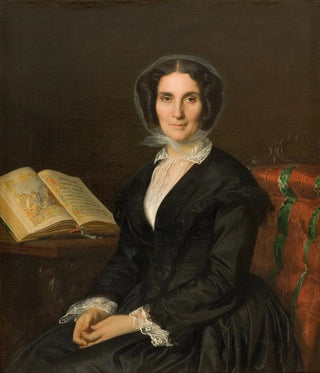Painting Madame Louise Mars - Alexandre Cabanel | Art print


View from behind

Frame (optional)
In the panorama of art history, certain works transcend the simple frame of painting to become true icons of their era. "Madame Louise Mars" by Alexandre Cabanel falls into this category. Created in the 19th century, this captivating art print depicts a woman with striking beauty, embodying both elegance and delicacy. The artist, renowned for his talent in capturing feminine sensuality, invites us to contemplate a moment frozen in time, where every detail reveals emotional depth and narrative richness. The art print of this work allows for a rediscovery of Cabanel's technical subtleties while paying tribute to an emblematic figure of his time.
Style and uniqueness of the work
Cabanel's painting is distinguished by its academic style, characterized by an exceptional mastery of light and shadow. "Madame Louise Mars" is a perfect example of this approach, where the delicate nuances of the model's skin contrast with the richness of the drapery surrounding her. The composition is carefully orchestrated, with each element arranged to guide the viewer's gaze toward the woman's face, whose enigmatic expression sparks curiosity and admiration. The use of warm colors and the precision of details, from the reflections in her hair to the ornaments around her, testify to unparalleled craftsmanship. This work does not merely depict a woman; it evokes an atmosphere, a feeling, a period. The sensuality emanating from this painting is both subtle and powerful, a characteristic that contributed to Cabanel's renown.
The artist and his influence
Alexandre Cabanel, born in 1823, is one of the most influential painters of the French academic movement. His work reflects an era where art was expected to be both technical and emotional. As a professor at the École des beaux-arts in Paris, he trained many artists who later marked art history. His ability to capture feminine beauty and his attention to detail made him an essential figure of his time. "Madame Louise Mars" is not just a representation of a woman; it

Matte finish

View from behind

Frame (optional)
In the panorama of art history, certain works transcend the simple frame of painting to become true icons of their era. "Madame Louise Mars" by Alexandre Cabanel falls into this category. Created in the 19th century, this captivating art print depicts a woman with striking beauty, embodying both elegance and delicacy. The artist, renowned for his talent in capturing feminine sensuality, invites us to contemplate a moment frozen in time, where every detail reveals emotional depth and narrative richness. The art print of this work allows for a rediscovery of Cabanel's technical subtleties while paying tribute to an emblematic figure of his time.
Style and uniqueness of the work
Cabanel's painting is distinguished by its academic style, characterized by an exceptional mastery of light and shadow. "Madame Louise Mars" is a perfect example of this approach, where the delicate nuances of the model's skin contrast with the richness of the drapery surrounding her. The composition is carefully orchestrated, with each element arranged to guide the viewer's gaze toward the woman's face, whose enigmatic expression sparks curiosity and admiration. The use of warm colors and the precision of details, from the reflections in her hair to the ornaments around her, testify to unparalleled craftsmanship. This work does not merely depict a woman; it evokes an atmosphere, a feeling, a period. The sensuality emanating from this painting is both subtle and powerful, a characteristic that contributed to Cabanel's renown.
The artist and his influence
Alexandre Cabanel, born in 1823, is one of the most influential painters of the French academic movement. His work reflects an era where art was expected to be both technical and emotional. As a professor at the École des beaux-arts in Paris, he trained many artists who later marked art history. His ability to capture feminine beauty and his attention to detail made him an essential figure of his time. "Madame Louise Mars" is not just a representation of a woman; it
12,34 €






